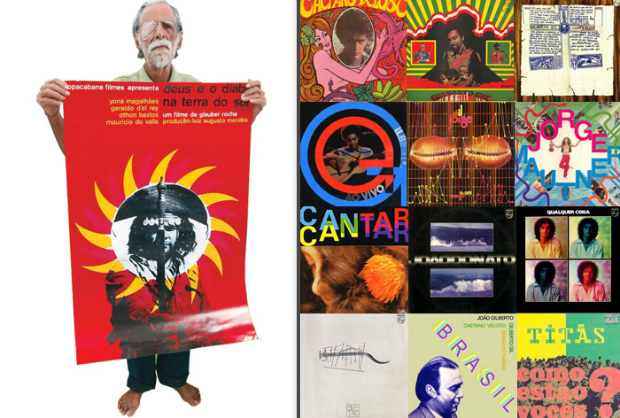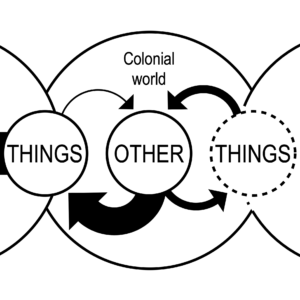
Summary: The coloniality of making refers to international relations of production that overvalue intellectual labor in developed countries and undervalue manual labor in underdeveloped countries. Design discipline plays a crucial role in maintaining the coloniality of making, establishing hierarchies between modes of designing existence in the world. The colonized populations’ ways of designing are considered bad, incomplete, picturesque, manual, or making without design. On the other hand, the colonial and imperialist way is considered good, innovative, intellectual, or a design without making. The work of Rogério Duarte, a Brazilian graphic designer, is presented as an example of someone who resisted the coloniality of making. Duarte sought an industrial design focused on use, need, and authenticity. Hence, he combined industrial with popular forms of culture in his designs.
Audio lecture recorded for the online Designs of the Oppressed (2022) course.
Full transcript
Coloniality of Making and its Resistance in Brazil. This is an attempt to establish a dialogue with a modernity coloniality group from Latin America that has done a lot to establish notions such as coloniality of knowledge by Aníbal Quijano, coloniality of power by Mignolo, and coloniality of being by Maldonado Torres.
I want to state that Alvaro Vieira Pinto, a philosopher from the 1950s and 70s who worked on a concept that could be interpreted as coloniality of making. He didn’t use those words; he spoke about metropolitanism and underdevelopment. However, we can perhaps relate his work to the modernity coloniality group and strengthen the collaboration bonds between those discussing the same phenomena.
Well, Vieira Pinto, in Brazil, an underdeveloped country, thought that we suffered from this underappreciation for what we already have made in our world. We always look at our world as unfinished and lacking something that can come from the developed world. Therefore, we need to make ourselves out of the making that comes from the outside. We never feel like we are good enough to make ourselves out from what we already have made.
Therefore, he found a dependence relationship that extends further than just objects and wants to make objects that look European or American. Instead, it goes up to making ourselves as human beings or making ourselves as collective entities like a nation differently from the examples that we find abroad.
That’s a big challenge: to become an autonomous country. That does not mean only having autonomous factories and markets but also an autonomous way of looking after ourselves and developing our culture. He was for sure influenced by the Brazilian modernist movements of the 1920s, which among other things, proposed the concept of anthropophagy, which means metaphorically eating the colonized and integrating their ideas and strengths within the tribe, but not without a good dose of critical exit. Anthropophagy is seeing what makes sense to our culture and what we already have made in our world.
Anthropophagy was very influential for cultural movements later on after the 20s. For example, in the 60s, a lot of Brazilian artists began reflecting on imperialism and the rise of the Cold War, and they decided to be autonomous and not align either with socialism or with capitalism. So this international third-worldism movement was taking steam. The fight for liberation in Africa inspired many Brazilian artists to stay critical of whatever came from abroad. Anthropophagy was certainly a significant influence, but it also mixed with new influences and generated movements like Cinema Novo in cinema and Tropicalia in music and the liberal arts in general.
Well, among the artists involved with Tropicalia, I would like to focus on Rogerio Duarte, who was also, among other things, a graphic designer. And he joined some Cinema Novo movie makers to produce motion graphics and posters for these movies. These movies were unique because they tried to show the social reality of the poor people in Brazil that was ignored by most of the cinema that mimicked Hollywood movies from the US.
Duarte created the best, perhaps the best, examples of an autonomous graphic design language in Brazil in the 60s that are still studied today. But he also worked as a musician, event organizer, and agitator. He worked with the National Union of Students (UNE) in organizing the popular cultural production units. And he created a lot of interesting subversive activities that tried to discuss and stop the influence, the critical influence of foreign ideas in Brazil. Thanks to these activities being considered subversive, he was persecuted, imprisoned and tortured by the military dictatorship in 1968. After that, he was mentally broken. He could not remake himself in the same way as he did before, and he searched for a different path towards his spiritual enlightenment.
Rogerio Duarte finally found solace in the Hare Krishna spiritual movement that came from India. He learned Sanskrit and translated the Bhagavad Gita, a major scripture from this movement. He also invited his fellow friends from previous years, famous musicians, to record tracks in this music album that adapted the Bhagavad Gita book.
I find this example very interesting that he extended, and expanded the notion of anthropology, not just eating the colonizer, but also eating the colonized. While doing so, I think he showed a path for us to fight the coloniality of making. We cannot fight them individually; we only have a chance if we do it collectively in our countries and nations. In fact, we must stabilize bonds of solidarity across different nations and form these South-to-South collaborations that may lead to fabrication networks that do not depend on global networks. This is perhaps an exciting way of fighting the coloniality of making.

